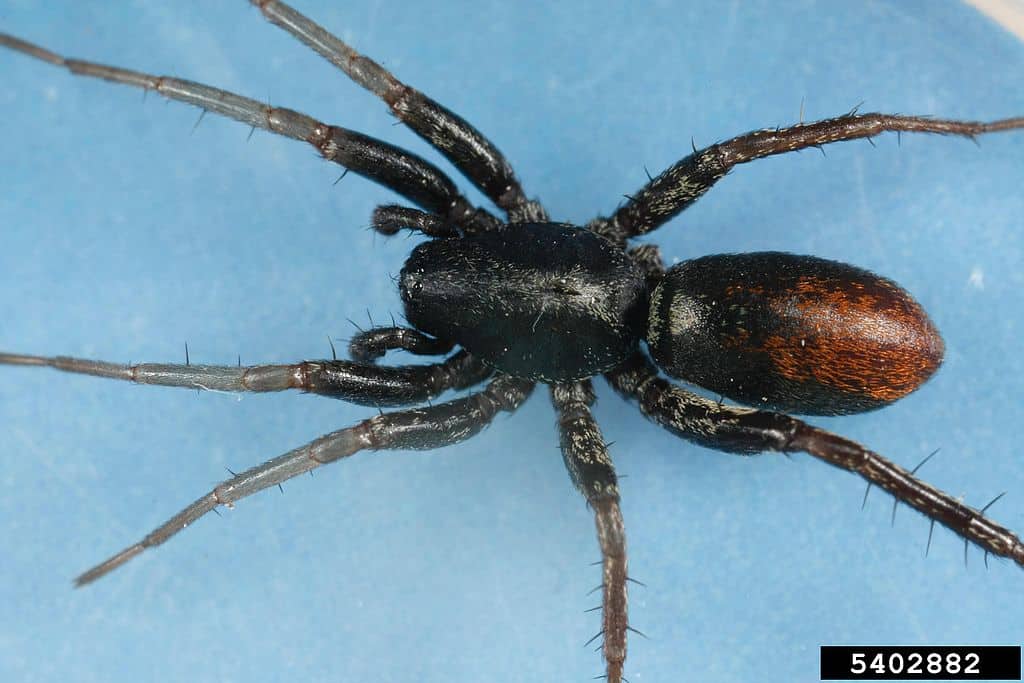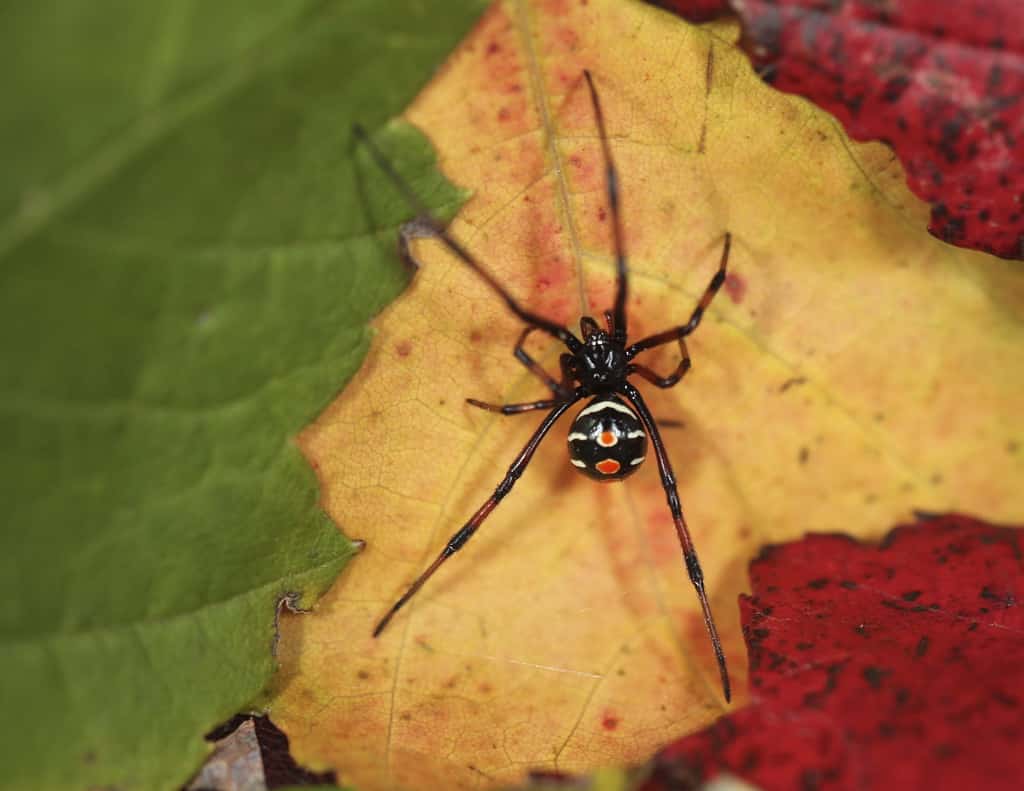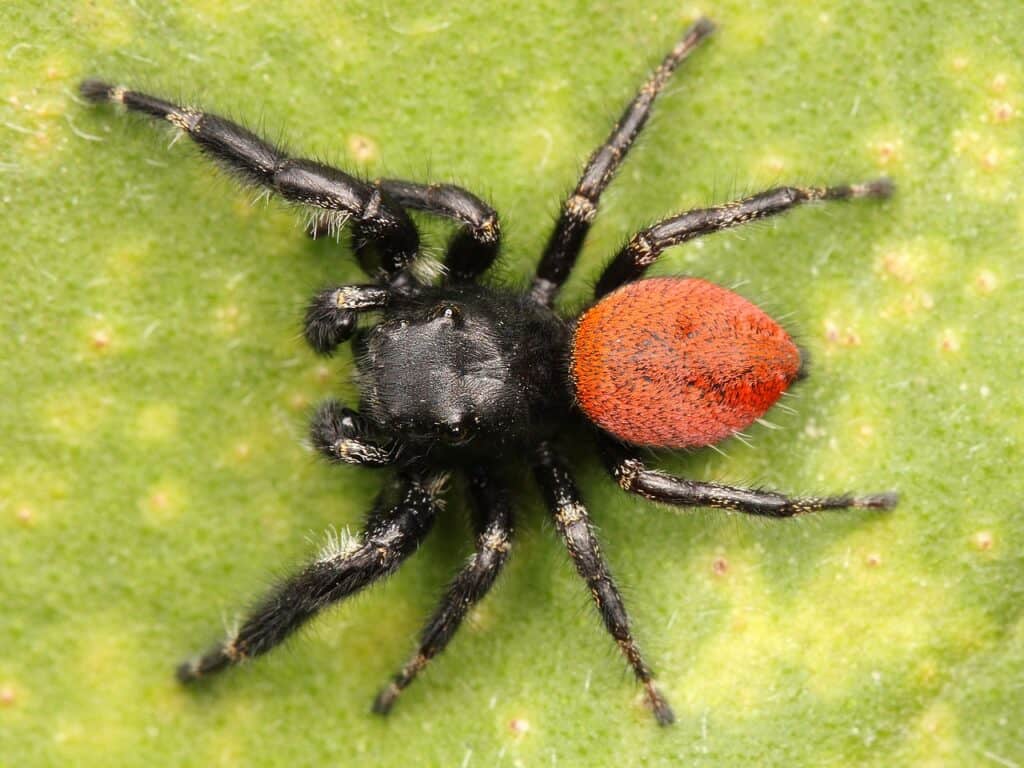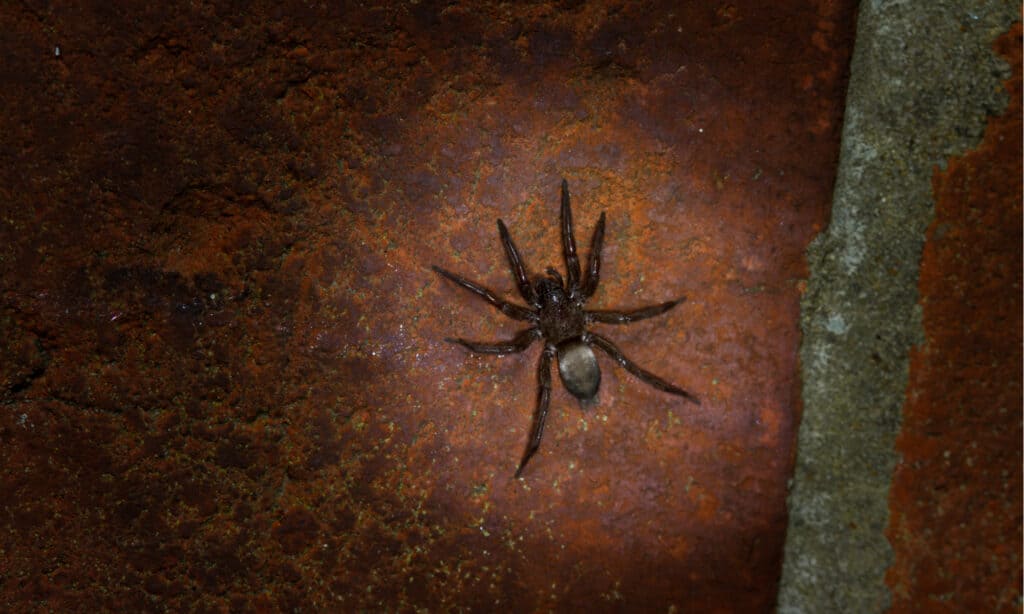Montana is home to a variety of spider species, including several black spiders that can be found within the region. While most spiders are harmless and are, in fact, essential in controlling insect populations, it is still a good idea to be familiar with the standard black spiders in Montana for your safety and knowledge. In this article, we will explore a selection of the more prevalent black spider species you might come across within the state.
Red-Spotted Ant-Mimic (Castianeira descripta)

The red-spotted ant mimic acts like an ant in order to sneak up on its prey.
©Joseph Berger, Bugwood.org; University of Georgia / CC BY 3.0, via Wikimedia Commons – License
The red-spotted ant-mimic is a fascinating spider species found in various regions across the United States, including Montana. This tiny spider, measuring up to half an inch, is known for its remarkable ant-like appearance. Displaying a reddish-brown to black coloration, it has a slender body with a constricted waist and long, slim legs that help it mimic the appearance of an ant. This clever mimicry allows the spider to approach ants without the prey becoming agitated with the presence of a predator.
The behavior of the red-spotted ant-mimic is also intriguing as it tends to move like an ant, frequently pausing and altering its direction, further enhancing its disguise. These spiders are recognized as diurnal, meaning they exhibit activity during daylight hours, in contrast to numerous other spider species. Their preferred habitats include leaf litter, logs, and under rocks or bark, where they can find ample prey.
As predators, these spiders primarily consume insects, with a diet mainly consisting of ants, small flies, and other soft-bodied insects. They employ a hunting strategy that involves stalking and ambushing their prey rather than constructing webs to catch them. When capturing their prey, they use their venomous bite to immobilize the victim, making it easier to consume.
The red-spotted ant-mimic’s venom is not considered dangerous to humans. Although a bite from this spider might cause localized pain, redness, and mild swelling, it typically poses no significant health risk. In general, these spiders are more inclined to flee from human contact than attack, further reducing their risk. However, with that said, a bite from this spider can still be dangerous if you are allergic to spider venom. So, if you experience more serious symptoms, go to the hospital immediately!
Northern Black Widow (Latrodectus variolus)

The northern black widow spider is typically non-aggressive, only biting when threatened.
©iStock.com/NajaShots
The northern black widow is a fascinating yet potentially dangerous spider species found in Montana. Despite their fearsome reputation, they are generally non-aggressive and will only bite when they feel threatened. This is primarily a defensive mechanism rather than an active hunting strategy. When encountering humans, these spiders would much rather avoid confrontation and retreat to the safety of their web.
Northern black widows exhibit similar mating behaviors to other widow spider species. Males seek out receptive females, and they mate after a complex courtship dance. In some cases, the female may consume the male after mating, hence the “widow” moniker. This behavior, however, is not as common as once believed and may only occur under certain circumstances, such as a lack of other available food resources.
Female northern black widows lay their eggs in silken sacs, often in close proximity to their web. These sacs can contain anywhere from 100 to 300 eggs, which will hatch into spiderlings after a few weeks. The spiderlings will then disperse, most likely using a method known as “ballooning,” where they release a strand of silk that catches the wind and carries them to new locations. This dispersal technique allows the species to colonize new habitats and maintain a wide distribution range.
As the northern black widow matures, it undergoes several molts, shedding its exoskeleton to accommodate growth. Like many other spider species, the northern black widow’s life cycle is relatively short, usually spanning around one to two years. This short lifespan is typical for many spider species, highlighting the importance of their reproductive strategies for species survival.
While the northern black widow’s venom can be harmful to humans, fatalities from bites are relatively rare, and the symptoms are usually limited to pain, swelling, and nausea. But if you suspect to have been bitten by a northern black widow, it’s important to seek medical attention immediately. Treatment may include antivenom, pain management, and wound care to prevent infection.
Conservation efforts are essential in maintaining the balance of ecosystems, and the northern black widow is no exception. As predators, they play a vital role in controlling insect populations, contributing to a balanced environment. Encouraging awareness and understanding of these creatures is crucial to minimize unnecessary harm and maintain their natural habitats.
Western Black Widow (Latrodectus hesperus)

The western black widows play a critical role in controlling insect populations in Montana.
©Paul Sapiano / CC BY 2.0 – License
The western black widow is a remarkable species of spider that has both fascinated and instilled fear in those who encounter it. Despite their ominous reputation and like many other misunderstood spider species, the western black widows play a critical role in controlling insect populations. As predators, they contribute to the natural regulation of their prey species, thereby promoting overall biodiversity and health within their habitats.
One interesting aspect of western black widow biology is their mating behavior. Males actively search for females by detecting pheromones released by the females. Upon finding a suitable mate, the male will perform a complex courtship ritual that may involve exhibiting specific body movements. These behaviors help convince the female of the male’s suitability as a mate and reduce the risk of cannibalism, which can sometimes occur post-mating.
After mating, the female western black widow will lay her eggs in a silken sac, often attached to her web. Each of these sacs may contain up to several hundred eggs, which will hatch into spiderlings after a few weeks. The spiderlings are initially cannibalistic, consuming their siblings to ensure only the strongest survive. This behavior, while brutal, is a common survival strategy among many spider species.
The western black widow’s venom potency is a source of much interest and study among scientists. The neurotoxin latrotoxin, found in the venom, has been studied for its potential medical applications. In controlled settings, the toxin has been investigated for use in certain medical and scientific scenarios. This highlights the importance of conserving and studying these species, as they may hold the key to valuable scientific discoveries and advancements.
However, it’s important to note that while the western black widow’s venom has potential medical applications, it is still highly toxic to humans and can cause serious health problems. While the spiders are generally non-aggressive and will only bite when they feel threatened, it’s still important to be cautious and seek medical attention if bitten.
Red-Backed Jumping Spider (Phidippus johnsoni)

Male red-backed jumping spiders perform complex dances where they display their colorful abdomens to attract females.
©Kaldari / CC0 via Wikimedia Commons – License
The red-backed jumping spider is a fascinating creature that has captured the interest of both scientists and nature enthusiasts alike. Due to their unique appearance and hunting techniques, they are often the subject of study and observation. Researchers have discovered that these spiders have intricate courtship rituals, with males performing complex dances and displaying their colorful abdomens to attract females. The females, in turn, are selective in choosing a mate, ensuring the continuation of their species’ strong genetic traits.
In their natural habitat, red-backed jumping spiders can be found in various environments, including grasslands, forests, and suburban gardens. They are resilient creatures that can adapt well to different surroundings. This adaptability has allowed them to thrive even in areas where human activity has encroached on their territories. In fact, they are known to be helpful in controlling populations of insects that are often regarded as pests. However, it is worth noting that although these spiders are beneficial in controlling insect populations, they are not necessarily selective in which insects they prey upon. In fact, they will often consume beneficial insects as well as pests.
The life cycle of the red-backed jumping spider is relatively short. Females lay eggs in silken sacs hidden in crevices or under rocks for protection. The eggs usually hatch within a few weeks, releasing spiderlings that closely resemble miniature versions of the adults. As they grow, the young spiders molt several times, shedding their exoskeletons to accommodate their increasing size. The full life cycle, spanning from egg to adult, may be accomplished within a year, contingent upon factors such as environmental conditions and the accessibility of food sources.
These spiders are solitary creatures, only coming together during the mating season. After the mating process concludes, the male and female part ways, leaving the female to assume the duty of safeguarding the egg sac.
Interestingly, red-backed jumping spiders exhibit a degree of parental care, with females most likely staying close to the egg sac until the spiderlings emerge.
In addition to their striking appearance and agile hunting skills, the red-backed jumping spider, as well as many other jumping spiders, is also known for its remarkable intelligence. Research has revealed that these spiders possess learning and problem-solving capabilities, exhibiting a capacity to modify their hunting techniques in response to varying circumstances. This level of cognitive skill is relatively rare among invertebrates, making the red-backed jumping spider a unique and captivating species.
Mouse Spider (Scotophaeus blackwalli)

The mouse spider has specialized hairs that allows it to detect vibrations, changes in air currents, and even chemical cues.
©thatmacroguy/Shutterstock.com
The mouse spider boasts a fascinating set of physiological and behavioral traits that further distinguish it from other spider species. One such feature is their set of eight eyes, which are arranged in two rows on the cephalothorax. Although their eyesight is not as acute as that of jumping spiders, it still serves them well for detecting prey and sensing their surroundings.
Mouse spiders also possess impressive sensory organs in the form of specialized hairs called setae. These hairs cover their body and legs, allowing them to detect vibrations, changes in air currents, and even chemical cues. This heightened sensitivity helps the spiders to navigate their environment, locate prey, and avoid potential threats.
The mouse spider’s mode of locomotion is another interesting aspect of their biology. Like other spiders, they rely on a hydraulic system to extend their legs, which allows for quick and efficient movement. This hydraulic system, coupled with their innate agility and ability to scale vertical surfaces, makes the mouse spider a formidable hunter and a master of its domain.
When it comes to communication, mouse spiders utilize a combination of chemical and tactile signals. They rely heavily on pheromones, which are chemical substances released by individuals to influence the behavior of other members of the same species. These pheromones play a crucial role in mating, as males will use them to locate and identify receptive females.
These spiders are nocturnal creatures and tend to be more active during the night. Mouse spiders are often found in houses, sheds, and other structures, where they can prey on insects and other arthropods. But despite their proximity to humans, don’t worry! They are not dangerous to humans and are not known to bite unless provoked or threatened.
Mouse spiders typically live for one to two years. This comparatively brief lifespan is common among numerous spider species, highlighting the significance of their reproductive tactics in guaranteeing the continuation of their kind. In the face of various environmental challenges and predators, mouse spiders must reproduce efficiently to maintain their populations.
The photo featured at the top of this post is © iStock.com/maria72
Thank you for reading! Have some feedback for us? Contact the AZ Animals editorial team.






